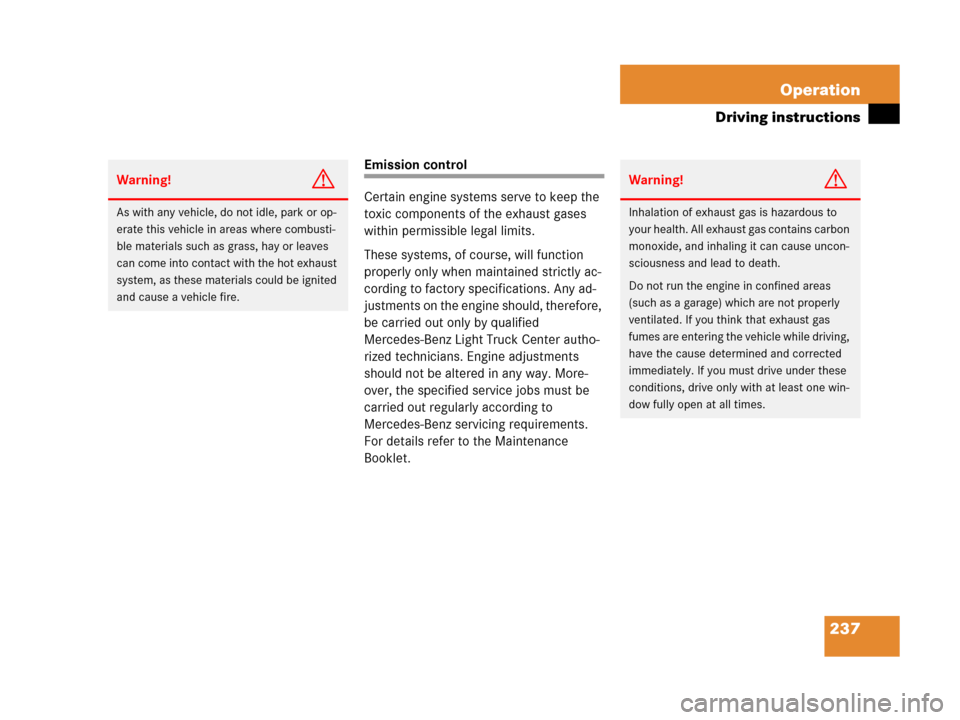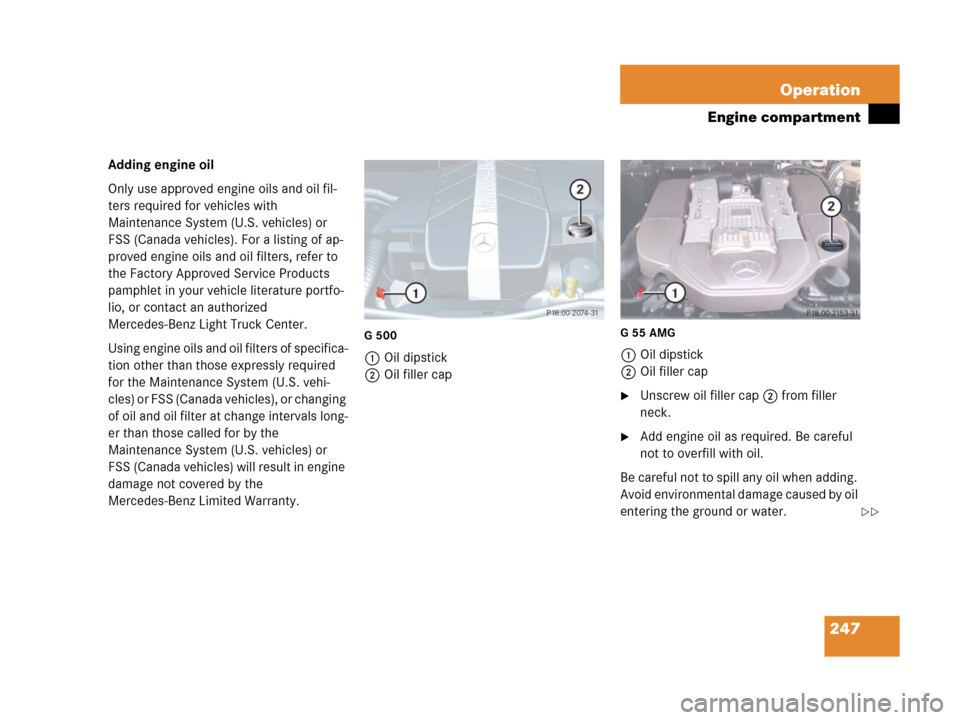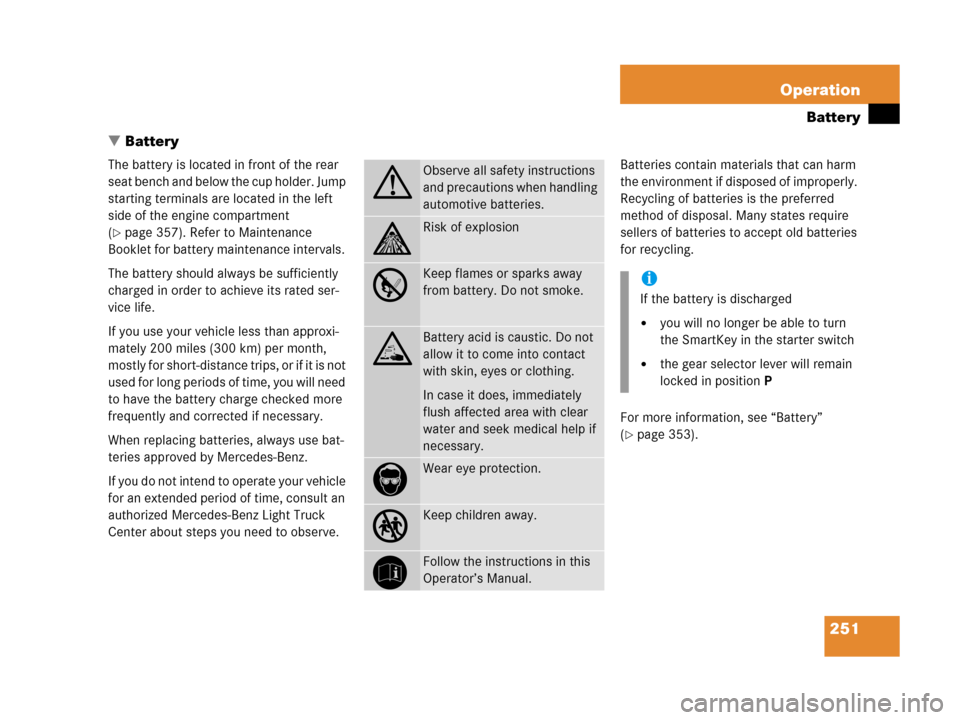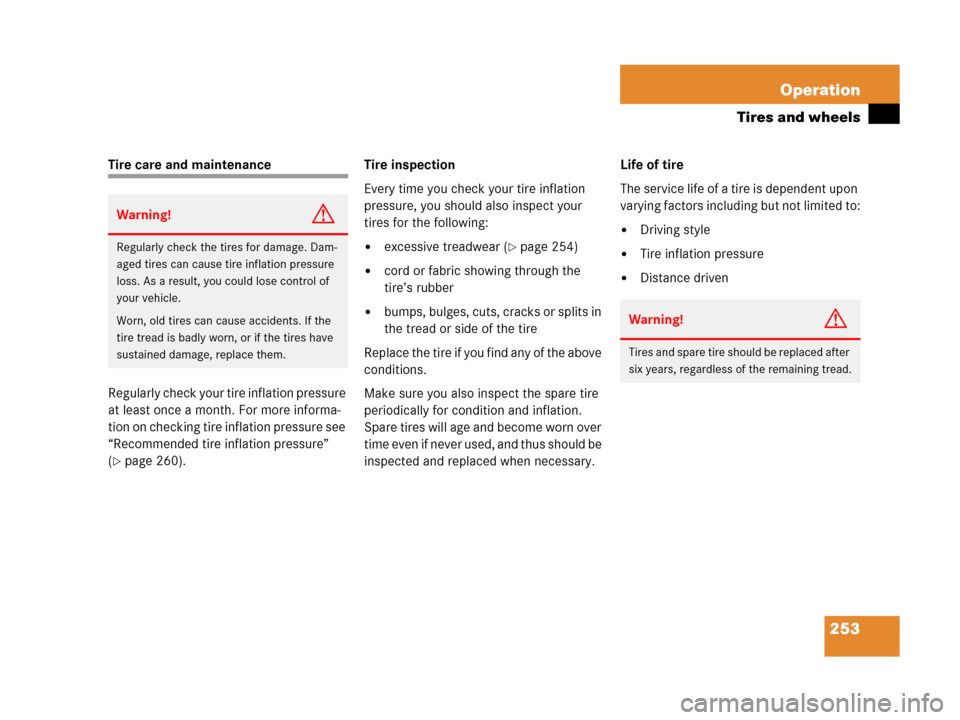Page 218 of 417
217 Operation
The first 1000 miles (1500 km)
Driving instructions
At the gas station
Engine compartment
Battery
Tires and wheels
Winter driving
Maintenance
Vehicle care
Page 220 of 417
219 Operation
The first 1000 miles (1500 km)
All of the above instructions, as may apply
to your vehicle type, also apply when driv-
ing the first 1000 miles (1500 km) after the
engine, the transfer case, the front differ-
ential or the rear differential has been re-
placed.i
G55AMG:
For better protection of the front and
rear differential, the oil must be
changed after a break-in period of
1900 miles (3000 km).
Changing oil in the front and rear
differential increases the service life
and helps reduce noise from the
differential locks.
See Maintenance Booklet for additional
information and Factory Approved
Service Products pamphlet for informa-
tion on the approved service product
required to perform the front and rear
axle oil change.
i
Always obey applicable speed limits.
Page 221 of 417

220 Operation
Driving instructions
Drive sensibly – save fuel
Fuel consumption, to a great extent, de-
pends on driving habits and operating
conditions.
To save fuel you should:
�Keep tires at the recommended infla-
tion pressures.
�Remove unnecessary loads.
�Allow engine to warm up under low
load use.
�Avoid frequent acceleration and decel-
eration.
�Have all maintenance work performed
at the intervals specified in the
Maintenance Booklet and as required
by the maintenance service display.
Contact an authorized Mercedes-Benz
Light Truck Center.
Fuel consumption is also increased by driv-
ing in cold weather, in stop-and-go traffic,
on short trips and in hilly area.
Drinking and drivingPedals
Warning!G
Drinking and driving and/or taking drugs
and driving are very dangerous combina-
tions. Even a small amount of alcohol or
drugs can affect your reflexes, perceptions
and judgment.
The possibility of a serious or even fatal ac-
cident are greatly increased when you drink
or take drugs and drive.
Do not drink or take drugs and drive or allow
anyone to drive who has been drinking or
taking drugs.
Warning!G
Keep driver’s foot area clear at all times. Ob-
jects stored in this area may impair pedal
movement.
Page 237 of 417

236 Operation
Driving instructions
Driving abroad
Abroad, there is an extensive
Mercedes-Benz service network at your
disposal. If you plan to drive into areas
which are not listed in the index of a
Mercedes-Benz Light Truck Center directo-
ry, you should request pertinent informa-
tion from an authorized Mercedes-Benz
Light Truck Center.Catalytic converter
Your Mercedes-Benz is equipped with
monolithic-type catalytic converters, an
important element in conjunction with the
oxygen sensors to achieve substantial con-
trol of the pollutants in the exhaust emis-
sions. Keep your vehicle in proper
operating condition by following our rec-
ommended maintenance instructions as
outlined in your Maintenance Booklet.!
To prevent damage to the catalytic con-
verters, use only premium unleaded
gasoline in this vehicle.
Any noticeable irregularities in engine
operation should be repaired promptly.
Otherwise, excessive unburned fuel
may reach the catalytic converter,
causing it to overheat and potentially
start a fire.
Page 238 of 417

237 Operation
Driving instructions
Emission control
Certain engine systems serve to keep the
toxic components of the exhaust gases
within permissible legal limits.
These systems, of course, will function
properly only when maintained strictly ac-
cording to factory specifications. Any ad-
justments on the engine should, therefore,
be carried out only by qualified
Mercedes-Benz Light Truck Center autho-
rized technicians. Engine adjustments
should not be altered in any way. More-
over, the specified service jobs must be
carried out regularly according to
Mercedes-Benz servicing requirements.
For details refer to the Maintenance
Booklet.
Warning!G
As with any vehicle, do not idle, park or op-
erate this vehicle in areas where combusti-
ble materials such as grass, hay or leaves
can come into contact with the hot exhaust
system, as these materials could be ignited
and cause a vehicle fire.
Warning!G
Inhalation of exhaust gas is hazardous to
your health. All exhaust gas contains carbon
monoxide, and inhaling it can cause uncon-
sciousness and lead to death.
Do not run the engine in confined areas
(such as a garage) which are not properly
ventilated. If you think that exhaust gas
fumes are entering the vehicle while driving,
have the cause determined and corrected
immediately. If you must drive under these
conditions, drive only with at least one win-
dow fully open at all times.
Page 248 of 417

247 Operation
Engine compartment
Adding engine oil
Only use approved engine oils and oil fil-
ters required for vehicles with
Maintenance System (U.S. vehicles) or
FSS (Canada vehicles). For a listing of ap-
proved engine oils and oil filters, refer to
the Factory Approved Service Products
pamphlet in your vehicle literature portfo-
lio, or contact an authorized
Mercedes-Benz Light Truck Center.
Using engine oils and oil filters of specifica-
tion other than those expressly required
for the Maintenance System (U.S. vehi-
cles) or FSS (Canada vehicles), or changing
of oil and oil filter at change intervals long-
er than those called for by the
Maintenance System (U.S. vehicles) or
FSS (Canada vehicles) will result in engine
damage not covered by the
Mercedes-Benz Limited Warranty.
G500
1Oil dipstick
2Oil filler cap
G55AMG
1Oil dipstick
2Oil filler cap
�Unscrew oil filler cap2 from filler
neck.
�Add engine oil as required. Be careful
not to overfill with oil.
Be careful not to spill any oil when adding.
Avoid environmental damage caused by oil
entering the ground or water.
��
Page 252 of 417

251 Operation
Battery
�Battery
The battery is located in front of the rear
seat bench and below the cup holder. Jump
starting terminals are located in the left
side of the engine compartment
(
�page 357). Refer to Maintenance
Booklet for battery maintenance intervals.
The battery should always be sufficiently
charged in order to achieve its rated ser-
vice life.
If you use your vehicle less than approxi-
mately 200 miles (300 km) per month,
mostly for short-distance trips, or if it is not
used for long periods of time, you will need
to have the battery charge checked more
frequently and corrected if necessary.
When replacing batteries, always use bat-
teries approved by Mercedes-Benz.
If you do not intend to operate your vehicle
for an extended period of time, consult an
authorized Mercedes-Benz Light Truck
Center about steps you need to observe.Batteries contain materials that can harm
the environment if disposed of improperly.
Recycling of batteries is the preferred
method of disposal. Many states require
sellers of batteries to accept old batteries
for recycling.
For more information, see “Battery”
(
�page 353).
G
Observe all safety instructions
and precautions when handling
automotive batteries.
A
Risk of explosion
D
Keep flames or sparks away
from battery. Do not smoke.
B
Battery acid is caustic. Do not
allow it to come into contact
with skin, eyes or clothing.
In case it does, immediately
flush affected area with clear
water and seek medical help if
necessary.
E
Wear eye protection.
C
Keep children away.
F
Follow the instructions in this
Operator’s Manual.
i
If the battery is discharged
�you will no longer be able to turn
the SmartKey in the starter switch
�the gear selector lever will remain
locked in positionP
Page 254 of 417

253 Operation
Tires and wheels
Tire care and maintenance
Regularly check your tire inflation pressure
at least once a month. For more informa-
tion on checking tire inflation pressure see
“Recommended tire inflation pressure”
(
�page 260).Tire inspection
Every time you check your tire inflation
pressure, you should also inspect your
tires for the following:
�excessive treadwear (�page 254)
�cord or fabric showing through the
tire’s rubber
�bumps, bulges, cuts, cracks or splits in
the tread or side of the tire
Replace the tire if you find any of the above
conditions.
Make sure you also inspect the spare tire
periodically for condition and inflation.
Spare tires will age and become worn over
time even if never used, and thus should be
inspected and replaced when necessary.Life of tire
The service life of a tire is dependent upon
varying factors including but not limited to:
�Driving style
�Tire inflation pressure
�Distance driven
Warning!G
Regularly check the tires for damage. Dam-
aged tires can cause tire inflation pressure
loss. As a result, you could lose control of
your vehicle.
Worn, old tires can cause accidents. If the
tire tread is badly worn, or if the tires have
sustained damage, replace them.
Warning!G
Tires and spare tire should be replaced after
six years, regardless of the remaining tread.